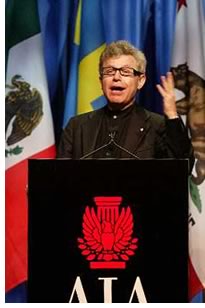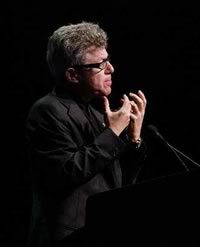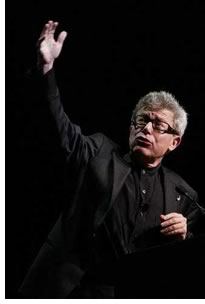

Architects Embrace Libeskind
and His Plans
for Lower Manhattan
 Daniel
Libeskind received a resounding standing ovation from more than 3,000
of his colleagues at the AIA convention in San Diego March 10 following
the passionate presentation of his vision for Lower Manhattan. The featured
speaker helped cap a three-day program that highlighted how the poetry
of architecture elevates the human spirit and how architects can search
for the proof to make the case that design influences society in ways
we are just beginning to understand.
Daniel
Libeskind received a resounding standing ovation from more than 3,000
of his colleagues at the AIA convention in San Diego March 10 following
the passionate presentation of his vision for Lower Manhattan. The featured
speaker helped cap a three-day program that highlighted how the poetry
of architecture elevates the human spirit and how architects can search
for the proof to make the case that design influences society in ways
we are just beginning to understand.
Through compelling images and rich language, the featured speaker articulated the symbolic and practical elements of his schemes, charismatically guiding the audience through the design process that resulted in Memory Foundations, the now well-publicized design for a 1,776-foot-tall tower, a memorial park that preserves the slurry walls of the original buildings, grand spaces for cultural events, and an extensive underground transit system. The architect, who counts “humankind” as his client, said he wanted to build a “great public space, taking a “quantum leap to create an organic composition.”
Quintessential New York
The design is “all about reactivating a city,” Libeskind told
the audience. His plans, he noted, mesh the intensity and complexity of
the site with simplicity and emotion, creating a space that captures passion,
spirituality, silence, and dignity while making room for the required
high-rise office and retail space and transportation improvements. It
captures the “vitality that is quintessential New York, and which
filters energy back to the city,” Libeskind said.
 Libeskind,
speaking with great animation, said the project that Architectural
Record Editor in Chief Robert Ivy, FAIA, called the “commission
of the new century,” is not about the ego of an architect, but rather
about “presenting a medium and capturing emotions.” Libeskind
said that his designs took into account the outpouring of public opinion
and imagined what the project would mean for the people of New York, where
there were so many victims “perishing in their everyday life.”
For further inspiration, Libeskind reread the Declaration of Independence,
the U.S. Constitution, poetry by Walt Whitman, and the writing of Herman
Melville. He incorporated the optimism he found in these works into his
design elements, such as symbolically programming the required “skyline
element” as a 1,776-foot-tall tower to reflect the aspirations of
a people who based their government on the ideas of freedom and equality.
Libeskind also noted that he took great care to bring into composition
the site’s other buildings, making sure the new plans fit into the
context of the city’s financial center area.
Libeskind,
speaking with great animation, said the project that Architectural
Record Editor in Chief Robert Ivy, FAIA, called the “commission
of the new century,” is not about the ego of an architect, but rather
about “presenting a medium and capturing emotions.” Libeskind
said that his designs took into account the outpouring of public opinion
and imagined what the project would mean for the people of New York, where
there were so many victims “perishing in their everyday life.”
For further inspiration, Libeskind reread the Declaration of Independence,
the U.S. Constitution, poetry by Walt Whitman, and the writing of Herman
Melville. He incorporated the optimism he found in these works into his
design elements, such as symbolically programming the required “skyline
element” as a 1,776-foot-tall tower to reflect the aspirations of
a people who based their government on the ideas of freedom and equality.
Libeskind also noted that he took great care to bring into composition
the site’s other buildings, making sure the new plans fit into the
context of the city’s financial center area.
He also mentioned reports skeptical that one of the featured design elements would work. Through solar orientation, a “wedge of light” is supposed to reflect off of the building and into an open plaza “where the sun would shine without shadow” each September 11 between 8:48 a.m., when the first plane hit, and 10:48 a.m., when the second tower fell. The design would work as planned, and the critics of the proposal were misinformed, Libeskind reiterated. Later, during a panel discussion on the future of the World Trade Center site that touched on how and whether his design would persevere, he said, “Architecture is about negotiations.”
 Historic
connections
Historic
connections
At age 13, the Polish-born Libeskind emigrated from Israel to the U.S.,
where he got his first glimpse of the city’s skyline, a vision he
said he continues to carry with him and integrated into the design. For
example, he said, the shape of the tall tower is based on the spiraling
flame of the torch of the Statue of Liberty.
Libeskind attended Cooper Union College where, during walks to class, he watched Minoru Yamasaki’s World Trade Center take shape and harkens back to experiencing the rise of the Twin Towers. After living and working in London and Berlin, Libeskind recently moved his residence and office to Lower Manhattan.
Libeskind said that for the most part he let the site speak in its own voice. He noted that he learned from the Port Authority of New York and New Jersey that he was the only architect to ask to go down into the slurry wall bathtub, a place he found spoke to human vulnerability but also constructive optimism because, Libeskind noted, “What is more optimistic than building?”
As part of his desire to create a better urban space, Libeskind said, he emphasized reconnecting the site with the Hudson River waterfront and opening up the city’s areas for cultural events, a future museum, and transportation routes previously cut off by the former buildings. The plan will be phased so that the “heartbeat of the world” is not just a constant construction site. Libeskind said he also looks forward to the competition for the memorial, which will descend into the original foundation, surrounded by the bathtub walls and further protected by cultural buildings.
After his presentation, Libeskind joined moderator Ivy and panelists Frances Halsband, FAIA, founding partner, R.M. Kliment & Frances Halsband Architects; Stanton Eckstut, FAIA, founding principal of Ehrenkrantz, Eckstut & Kuhn; and Paul Goldberger, Hon. AIA, Pulitzer-prize-winning architecture critic of The New Yorker, in a discussion about the issues surrounding the development of the World Trade Center site.
Copyright 2003 The American Institute of Architects.
All rights reserved. Home Page ![]()
![]()
 |
||
| Click here to read more about the Memorial Competition. Click here to read about the panel on the future of Lower Manhattan featuring moderator and Architectural Record Editor in Chief Robert Ivy, FAIA; Frances Halsband, FAIA, founding partner, R.M. Kliment & Frances Halsband Architects; Stanton Eckstut, FAIA, founding principal of Ehrenkrantz, Eckstut & Kuhn; and Paul Goldberger, Hon. AIA, Pulitzer-prize-winning architecture critic of The New Yorker.
|
||